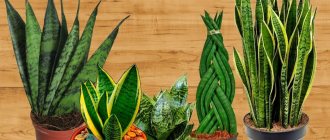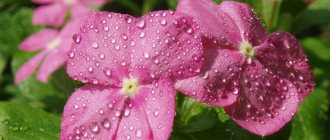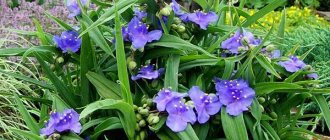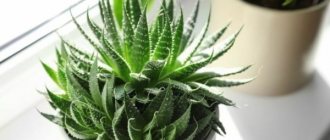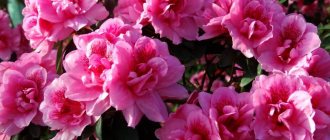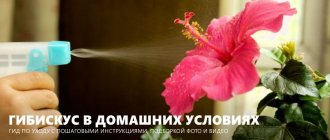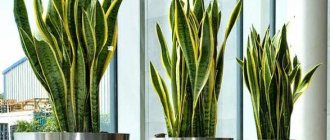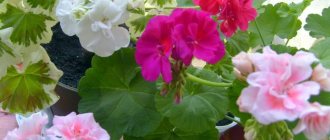Tradescantia is a decorative vine from the Commelinaceae family. The homeland of the evergreen perennial is South America. The wild culture was brought to Europe at the beginning of the 17th century. The court botanist and gardener John Tradescant, together with his son, also named John, traveled the world and collected exotic plants. In the royal parks they studied and bred Tradescantia. The flower is named in their honor.
Description of Tradescantia
The homeland of Tradescantia indoors is the tropical and subtropical regions of both Americas. It is a perennial herbaceous plant with a long stem. The latter is densely dotted with small fleshy ovoid leaves. Thanks to their beauty, Tradescantia has gained such popularity among modern lovers of indoor flowers. In different species of this plant, the color of the leaves may vary.
There are flowers with purely green plates, as well as with two-color or even purple ones. Both the leaves and the stem are covered with thick whitish hair. Tradescantia flowers (a photo of this plant can be seen on the page) are not very spectacular. The color of the buds can vary from white and pink to blue and purple. Tradescantia grows quite tall, losing some of its decorative qualities. Therefore, experts advise replanting or updating it more often.
Feng Shui meaning
According to Feng Shui, all plants have unique energy. To maintain the energy balance in your home, it is best to place them where they can provide benefits. For example, the east, which is the green sector, suggests the presence of flowers in rooms to maintain the concentration of Wood energy, if this is favorable for those who live in that room or apartment.
Tradescantia as a houseplant will fit perfectly into the southern corner because it concentrates the Fire element and needs the support of Wood. However, the Fire element can only be strengthened if it has a beneficial effect on someone in the household.
Indoor Tradescantia can also be useful when activation of sexual energy is needed. To do this, on the south wall of the bedroom, where a couple of lovers spend the night, you need to place or hang nine pots of Tradescantia. After two weeks, the fiery energy in the room will increase so much that it can be transmitted to the people living in it. As a result, sexual relationships will become much better.
And since Tradescantia is a plant that can also cleanse space on an energetic level, it is simply necessary in the fight against negative situations and bad energy combinations. However, don’t get carried away and place it everywhere.
Harmony is not based on the quantity of any element, but on the quality of the interaction of all elements. Therefore, there is no need to place Tradescantia, say, in a place where the Wood element would conflict with other energies. For example, you should not place a flower in the west, northwest, northeast and southwest . Tradescantia, despite the love of many gardeners, cannot be placed in the southeastern sector. After all, this is the direction of the Earth, which stores Water, thanks to which the Wood element strengthens, destroying the structure of the southwestern room.
The Wood element goes well with the Water element in the northern room. But if this element is unfavorable for the people living in it, then a flower placed there can cause harm.
Bright green climbing plants usually represent the Wood element, which can have a major impact. For this reason, they should not be placed in a child's room, because Wood has a destructive effect on parts of the body related to the Earth elements, for example: muscles, tendons, bones and stomach.
For the same reason, the plant should not be placed in the room of people suffering from allergies, problems with the liver, stomach, skin and teeth . Ultimately, these health problems arise from a lack of the Earth element - Wood can weaken it even more.
However, this type of energy has a beneficial effect on certain areas of life. For example, its high concentration can protect against unwanted pregnancy. For the same reason, a large number of such plants in the bedroom can contribute to male and female infertility.
Tradescantia in nature
As already mentioned, the birthplace of Tradescantia indoors is the American subtropics. This plant is most widespread in the southeastern part of North America. In the countries of this continent, Tradescantia is considered a malicious weed. In nature, this is a ground cover plant with rather sparse leaves and a shallow root system. This flower was named in honor of the world-famous naturalist, experienced gardener and enthusiastic collector - John Tradescant. He served as the chief gardener to the English king and traveled a lot around the world, collecting the most beautiful and interesting plants. It was this researcher who first made a description of the Commelinaceae family, including Tradescantia.
Content
- 1. Description 1.1. Popular varieties
The genus Tradescantia is part of the Commelinaceae family.
Represented by 75 species of evergreen herbaceous perennials, creeping plants and semi-succulents. Tradescantia was first described by Carl Linnaeus. Its name is given in honor of the Tradescants, a famous British dynasty of naturalists and travelers.
The popular name, “the eternal Jew,” comes from the legend of the mystical wanderer Agasfer. The rapid spread of the plant's shoots is compared to its wanderings around the world.
Tradescantia is native to the New World, where it grows from southern Canada to northern Argentina, including the West Indies. Gradually spread throughout the subtropics and tropics of Eurasia, Africa, Australia and Oceania.
IN THE PHOTO: Young riverside Tradescantia (Tradescantia fluminensis) in its natural environment. Photo by Bundanon Trust.
European scientists introduced the genus in 1629. Most likely, Tradescantia virginiana was the first to be cultivated.
Zebrina tradescantia
Tradescantia, of which there are various types, is usually a creeping plant. This type of exception does not represent an exception in this regard. This is a rather beautiful hanging plant with purple-red stems. The leaves of this variety are ovate, with a pointed tip, reddish-green, with silver veins. The bottom of the plates have a purple tint. The flowers of zebra tradescantia are pink and can reach 1-2 cm in diameter.
Riverside tradescantia
The shoots of this species are also creeping. They can reach four meters in length. The homeland of Tradescantia is America, where this wonderful plant (when in contact with water or soil) produces roots at the places where the leaves are attached. Of course, this property is preserved even in room conditions. The leaves of this variety can reach 6 cm in length and are ovoid in shape. Their color varies depending on the variety. Very beautiful, for example, is the riverside Tradescantia Variegata, which has white-green leaves. Quicksilver's are silvery-green, while Maiden's Blush is prized for the bright pink color of its young shoots.
News:
Article date: 06/15/2007Family: Commelinaceae.
Homeland: tropical and temperate regions of America.
Flowering: depending on the species from spring to autumn.
Growth: fast.
Light: bright diffused. Can also tolerate direct sunlight (in limited quantities). Green-leaved forms tolerate shade.
Temperature: in the spring-summer period around 18-25°C. In autumn and winter it prefers cool conditions (12-16°C), but can tolerate warmer conditions.
Watering: abundant, as the top layer of the substrate dries in spring and summer. In autumn and winter, watering is moderate.
Air humidity: does not play a significant role. In summer it is recommended to spray.
Feeding: in spring and summer at least 2 times a month with organic and complex mineral fertilizers. Variegated forms should not be fed with organic fertilizers. In autumn and winter without fertilizing.
Pruning: Tradescantia stems are prone to bareness, so timely pruning and pinching them helps to form the desired shape of the plant.
Rest period: not expressed. T. Virginskaya and T. Anderson have a pronounced dormant period in the autumn-winter period.
Transplantation: young plants once a year, mature plants after 2-3 years, in the spring, combined with pruning long shoots.
Reproduction: by seeds, cuttings or dividing the bush.
The genus Tradescantia L. includes 30 species of plants from the Commelinaceae family. They grow in tropical and temperate zones of America.
The name “Tradescantia” appeared in the 18th century and comes from the name of the gardener of the English King Charles I, John Tradescant (the elder), who described this plant. Tradescantia is popularly known as “woman's gossip” (as is saxifrage).
Tradescantia are perennial low-growing herbaceous plants. Shoots are creeping or straight. Leaves are elliptic, ovate, lanceolate, alternate. The inflorescences are axillary, located in the axils of the upper leaves and are apical. Tradescantia are one of the most common and easy-to-care indoor hanging plants. The dense greenery of the plant's shoots is quite easy to obtain by pinching, which enhances branching.
Tradescantia should be placed in rooms so that its long, creeping shoots can hang freely. They are placed in hanging vases, flowerpots or placed on shelves or high furniture. Tradescantia blooms well indoors. Bluish or blue-violet flowers appear at the ends of long stems.
Tradescantia varieties Anderson and Virginskaya are used for open ground in central Russia.
Tradescantia contains a complex of nutrients and medicinal substances. Aquarists place a pot of young Tradescantia on glass lying on the sides of the aquarium, and the growing stems of the plant soon sink into the water and form a beautiful green mat on its surface.
Tradescantia purifies and humidifies the air in the room, neutralizes electromagnetic radiation.
Kinds:
Anderson's Tradescantia a (T. x andersoniana Ludw. et Rohw) – photo. Complex garden hybrids involving Tradescantia virginiana are combined under this name. This should include most of the hybrid forms and varieties cultivated under the name T. virginiana. a Plant 30-80 cm tall with erect, branched, angular stems, leafy along the entire length. The leaves are linear-lanceolate, violet-green. The flowers are flat, purple, blue, pink or white, collected in an umbellate inflorescence. They bloom from June to September. Has many varieties. The best varieties: JG Weguelin - large, bright, sky blue flowers; Iris - deep blue flowers; Purewell Giant – carmine red flowers; Leonora - violet-blue flowers; Osprey - white flowers.
T. white-flowered (T. albiflora Kunth) - photo above. Synonyms: in the literature it is referred to as T. tricolor (T. tricolor hort. ex S. V. Clarke), T. uridis (T. uiridis hort.) . The plant's homeland is Tropical South America. Creeping shoots. The leaves are oblong-broadly ovate, 4-6 cm long and 2-2.5 cm wide, pointed at the apex, bare on both sides, green or silvery-variegated, glossy. Inflorescences are apical, sometimes axillary. The flowers are small, white; bracts are white. There are several varieties and varieties in the culture: albovittata - with white stripes on the leaves, tricolor - with white and pinkish-lilac stripes on the leaves, aurea - with green stripes on yellow leaves, aureovittata - leaves on top with longitudinal golden-yellow stripes.
T. Blossfeld (T. blossfeldiana Milb). The plant is native to Argentina. A perennial herbaceous semi-succulent plant with creeping and erect greenish-red stems. The leaves are alternate, sessile, with tubular sheaths, oblong or elliptic, with an acute or pointed apex, 4-8 cm long, 1-3 cm wide, dark green above with a slight reddish tint, purple below. The leaves below, leaf sheaths and stems under the nodes are densely pubescent with long white erect hairs. Flowers are on long, densely pubescent pedicels in paired curls at the ends of the shoots and in the axils of the upper leaves. The inflorescences are surrounded below by two leaf-shaped bracts of unequal size. There are 3 sepals, they are free, purple, densely pubescent. Petals 3, free, white in the lower half, bright pink at the top. The filaments in the lower third are covered with long white hairs. If the leaves have wide, few stripes of yellow color, and two adjacent right leaves have similar patterns (the neighboring left ones have the same pattern, although they differ in pattern from the right ones), then this is a form of variegata . With insufficient lighting, inept cuttings or pruning, the beautiful stripes on the leaves may disappear.
T. virginiana (T. virginiana L.) - photo. The plant's homeland is the southeastern regions of North America. A perennial plant with erect, branched, knotty stems 50-60 cm tall. The leaves are linear-lanceolate, up to 20 cm long, with a small sheath covering the stem. The flowers are three-petalled, pink-violet, up to 4 cm in diameter, numerous, collected in umbrella-shaped inflorescences at the top of the stems, under which there are two large, keeled bracts - photo. Blooms from early July to August for 60-70 days. The fruit is a capsule that opens with longitudinal flaps. Can be used as a hardy ground perennial. It has varieties: coerulea - blue flowers; rubra - red flowers;. atrorubra - blood-red flowers; rosea - pink flowers. Most forms and varieties indicated in catalogs under this name should be classified as T. Anderson (T. x andersoniana).
T. hairy (T. pilosa Lehm.) - distinguished by erect stems and elongated leaves with thick white pubescence. The flowers are lilac-pink.
T. zebra-shaped (T. zebrina hort. ex Bosse). Synonym: T. pendula (Schnizl.) DR Hunt), Zebrina pendula Schnizl. The shoots are creeping or hanging, glabrous, often reddish. The leaves are oblong-ovate, 8-10 cm long, 4-5 cm wide, the upper surface is green with two silvery-white stripes along the leaf. The lower part of the leaf is red. The flowers are small, purple or violet.
T. navicularis (T. navicularis Ortg.) - photo. The homeland of the plant is Mexico, Peru. Succulent plants with creeping bare shoots. The leaves are ovate, boat-shaped, small, 4-2 cm long and up to 1 cm wide, thick, pointed, keeled below, densely dotted with purple dots, ciliated at the edges. The inflorescence is apical. Flowers with pink petals. Highly decorative ampelous plant.
T. variegated (T. multicolor) has dense, small, green leaves with white and pink stripes. A very decorative, densely growing species.
T. riverine, or myrtifolia (T. fluminensis Veil. ar T. myrtifolia hort.). The homeland of the plant is Brazil. The shoots are creeping, purple-red, with green spots. The leaves are ovoid, 2–2.5 cm long and 1.5–2 cm wide, dark green above, lilac-red below, smooth on both sides; petiole short. Commonly grown varieties are variegata (variegated) with frequent cream stripes and Quicksilver with white stripes.
| T. x andersoniana | T. zebrina (Zebrina pendula) | T. fluminensis |
Plant care:
Tradescantia develops better in places with bright, diffused light (although it can withstand direct sunlight), but can also tolerate partial shade. The best places for growing are near windows facing west or east; they can grow near a north window; shading is required near a south window in the summer. Variegated forms need more light. In low light, variegated forms lose color, often turning green, and vice versa - they are colored very intensely and variegated on a sunny window. If there is too much direct sunlight, Tradescantia leaves may fade. The most shade-tolerant Tradescantia is white-flowered. In the summer, indoor Tradescantia can be taken out to a balcony protected from the wind and direct sun or planted in the garden (but you must remember that Tradescantia is very fond of slugs and aphids can attack).
Tradescantia grows well in both warm (with an average temperature of 25℃) and cool rooms (where in winter the temperature can fluctuate between 8-12℃). The plant tolerates warmer wintering well.
Tradescantia needs abundant watering in the spring and summer, and the water should not stagnate in the pot. Water a day or two after the top layer of soil dries. In winter, the substrate is kept moderately moist. Water it two to three days after the top layer of the substrate has dried. It is necessary to ensure that water does not accumulate in the pan all year round. Half an hour after watering, the unabsorbed water from the tray must be drained and the tray wiped dry with a cloth. Watering is done with soft, well-settled water. When kept in a cool place (about 12-16°C), Tradescantia is watered rarely, only after the soil has dried. Tradescantia can tolerate prolonged drying out of the earthen coma, but this weakens the plant.
Air humidity does not play a significant role, but plants like spraying, especially in the summer.
Feed during the growing season (spring and summer) at least 2 times a month with organic and complex mineral fertilizers. Variegated forms should not be fed with organic fertilizers, as this may cause the original color of the leaves to be lost. In autumn and winter they do not feed.
A feature of indoor Tradescantia is rapid aging, growth and loss of decorativeness: the leaves at the base of the stems dry out, the shoots become bare. To rejuvenate the plant, annual short pruning and pinching of shoots and replanting the plant in fresh soil are practiced.
Plants are replanted in the spring, young ones once a year, adults after 2-3 years, combined with pruning long shoots. The substrate is suitable humus, closer to neutral (pH 5.5-6.5). The plant grows well in a mixture of 2 parts deciduous soil, 1 part each turf and humus soil with a small addition of sand. Ready-made soil for Tradescantia is available for sale. The bottom of the pot needs good drainage.
Tradescantia is propagated by seeds, cuttings or dividing the bush.
Can be propagated by seeds in spring. Seeds are sown in March in mini-greenhouses. I use peat + sand substrate (1:1). Maintain temperature within 20°C. Constantly spray and ventilate the container with seeds. Seedlings bloom in the third year.
Tradescantia is very easily propagated by cuttings at any time of the year. Shoots are cut into cuttings (the size of the cuttings is 10–15 cm long). They are planted in pots of 5-10 pieces. Cuttings take root within a few days at a temperature of 10-20℃. The substrate for planting plants consists of compost soil - 1 tsp, humus - 1 tsp, sand - 1 tsp. The optimal acidity of the substrate is pH 5–5.5. After rooting, after 1-1.5 months, the plants have a completely decorative appearance.
Cut branches of Tradescantia can be placed in a vase with water, where they can be stored for many months and even years. You just need to add a little fertilizer to the water from time to time.
Precautions: The entire Tradescantia pallidum plant is slightly poisonous and can cause skin inflammation.
Possible difficulties:
Due to lack of light, moisture and nutrition, there are few leaves on elongated stems.
Due to lack of light, variegated leaves turn green
Due to lack of moisture, the stems become limp and yellow spots appear on the leaves.
By spring, the plants can stretch out, the leaves from the base of the stem dry out, they can be renewed with young rooted cuttings.
Excessively dry air causes the tips of plant leaves to turn brown.
With insufficient lighting, inept cuttings or pruning, the beautiful stripes on the leaves of plants may disappear.
Damaged by: various rots.
Discuss the article and care on the forum
Share the link
Materials used in the article:
Saakov S.G. Greenhouse and indoor plants and their care. - L.: Nauka, 1985. - 621 p.
Indoor floriculture / R. Milevskaya, Y. Vies. - Mn.: Book House, 2005. - 608 p., ill.
https://www.htk.fi/Terola/MATTI/tieto/2581%20tradeander.htm
https://web.mac.com/stephenhart/……EACD18C5-11F3-4E98-9840-BE96A0D1F9B8.htm
https://davesgarden.com/pf/showimage/35787/
https://www.indoor-plant-care.com/indoor_plant.asp?title=Tradescantia+navicularis…
How to care for a plant
The homeland of Tradescantia indoors is the swampy areas of the tropics. Therefore, all its varieties are moisture- and light-loving. It is best to place a pot with this plant on a windowsill. Its leaves and stems should receive at least some direct sunlight. In partial shade, Tradescantia (with purely green leaves) will also grow, but its color will not be as bright.
This plant needs to be watered frequently in the summer. The soil under Tradescantia should be constantly moist. In cold weather, watering is reduced, but not completely canceled. This indoor plant also tolerates dry air very poorly. Therefore, in summer it is sprayed at least twice a day.
Fertilize Tradescantia in spring and summer. In this case, they use a special fertilizer for ornamental plants, which can be purchased in a specialized store. Apply it to the soil once every two weeks.
Medicinal properties of Tradescantia zebrine
The benefits of this plant are known all over the world. In terms of its medicinal properties, zebrina is second only to aloe and echinacea. Official medical organizations did not recognize Tradescantia for a long time, but Venezuelan biologist Jonathan Piererro proved its benefits. The scientist discovered that its juice contains a substance that lowers blood sugar as effectively as insulin. The plant is rich in phytoncides that fight germs and viruses. They are useful for treating infections of the gastrointestinal tract, bronchitis, intercostal neuralgia, pneumonia, and colds. Methods of using medicinal flower:
- Prepare a tincture by pouring chopped stems and leaves with vodka in a ratio of 1:3. Leave for a week in darkness and coolness. Strain. Take a third of a glass three times a day before meals for colitis. The course of treatment is one month.
- Remedy for diarrhea. Grind a stem about 20 cm long. Pour 200 ml of very hot water. Leave for 2 hours, strain. take half a glass twice a day half an hour before meals.
- For diabetes mellitus. Chop three stems 20 cm long. Pour in half a liter of vodka. Insist for two weeks. Strain. 1 tsp. Dilute the tinctures in 50 ml of water. Take three times a day, a quarter of an hour before meals. After a month of use, take a two-week break.
Decoction
There are many ways to use this remedy. First you need to prepare a decoction. To do this, pour 100 g of chopped stems and leaves into 1.5 liters of boiling water. Leave for two hours. Directions for use:
- For colitis, do an enema with a decoction every evening for a week in a row. After a one-day break, carry out the procedure again for a week. Take 2-3 courses in three months.
- If you have periodontal disease, rinse your mouth with a decoction. Spread one glass of liquid over three to four treatments.
Porridge of leaves for lotions
There are several ways to use a mass of plant parts minced through a meat grinder. Recipes using a paste of leaves and stems:
- For scratches and cuts. Fresh and crushed stems and leaves must be applied to the affected area. You need to secure the compress with a bandage and plaster. This will stop the bleeding and prevent infection from developing.
- For hematomas. Apply the paste to the injury, securing it with a bandage and plaster. Keep this compress all night. In the morning, a significant part of the tumor will resolve.
Juice of stems and leaves
The squeezed liquid is used to treat a variety of diseases. To prepare the juice, add 150 g of chopped stems and leaves with water. leave for 2 hours. Drain the liquid and pass the raw materials through a meat grinder. Squeeze through two layers of gauze. The product loses all its beneficial properties after two hours, so it must be prepared in small portions. Options for using plant juice:
- For boils and boils. Mash the leaves and stems into a paste. Squeeze out the juice. Warm it up a little and soak a gauze pad. Apply to the boils and secure. Change the bandage every 2 hours during the day, and at night make a compress soaked in 30% tincture of the plant.
- Wipe your face with a solution of juice and water twice a day. It is capable of rejuvenating the skin.
- If you have a cold, dilute the juice with a little water and use it to gargle and rinse your nose.
Reproduction
America is the birthplace of Tradescantia, where it reproduces mainly vegetatively, that is, it produces roots from the nodes of the stem. In indoor conditions, you can grow it from seeds, from cuttings, or by dividing the bush. The second method is used most often. This plant can be propagated using cuttings at any time of the year. For this purpose, planting material about 15 cm long is suitable. Cuttings should be planted 5-8 pieces per pot. Their rooting occurs very quickly - within a few days.
Tradescantia seeds are very difficult to obtain, and therefore this plant is rarely propagated in this way at home. Bush division is used more often. However, Tradescantia can be propagated in this way only in the spring, that is, when young shoots begin to grow on it.
Secrets of success
Growing indoors:
Young Tradescantias are replanted once a year in the spring, mature specimens - once every two years. To avoid damaging the roots, it is better to replace plant replanting with transshipment.
Tradescantia quickly ages and loses its decorative effect. Instance aging is slowed down in two ways:
- annual pinching of shoots;
- anti-aging pruning every two to three years.
A period of “rest” is desirable from October to February.
IN THE PHOTO: Indoor Tradescantias benefit from summer healing in the fresh air.
Photo by @mamacasonopolous. Growing in the garden:
Tradescantia effectively displaces many weeds. It is worth planting where you need to stop the growth of weeds.
Spreading clumps of Tradescantia visually smooth out the edges of ponds, transitions between flower beds and lawns, and the lines of garden paths.
Plants look spectacular in combination with Bathworts, Goldenrods, Gaillardias, Daylilies and Hostas.
IN THE PHOTO: Outdoor composition of Tradescantia and white-flowering Begonia. Photo by @kobata_growers.
If severe and prolonged frosts are expected, it is important to protect Tradescantia from freezing with peat mulch.
What problems may arise when growing Tradescantia?
From time to time, Tradescantia at home begins to look sick and lethargic. The reasons may vary. For example, if the tips of Tradescantia leaves begin to dry out and turn brown, it means that you need to increase the humidity in the room or at least move the pot away from the central heating radiator. The cause of this problem is usually excessive dry air.
If this is combined with lethargy of the stems, it means that the plant simply does not have enough water. That is, you need to increase the frequency of watering. If there is too much water, the Tradescantia stem near the soil will turn brown and begin to rot. Lack of lighting is manifested in this plant by loss of leaf color.
Why do you dream?
- If you dreamed of this flower, changes await you in your personal life. Seeing Tradescantia in a dream means that soon a person will appear, a relationship with whom will bring many happy moments and fill life with new meaning.
- For a woman, a dream in which tradescantia is present promises to receive unambiguous signs of attention. For a man, such a dream predicts that he will soon meet a girl who will be a good housewife, capable of creating comfort in the house.
- If people are present with the flower, then soon you will participate in a wedding celebration or a magnificent celebration of a birthday or name day. If you dreamed of Tradescantia with animals, then you will meet with an old friend.
- Other sources interpret the tradescantia seen in a dream as a warning about upcoming worries and excitement before a responsible task.
Pests and diseases
Tradescantia flowers are quite beautiful, but, unfortunately, they are often attacked by harmful insects. One of the most dangerous is the spider mite. In addition to infection, dry air leads to its appearance on the leaves that it damages. A sign of a plant being damaged by spider mites is the presence of cobwebs in the internodes. The leaves of diseased plants begin to fall.
In order to rid Tradescantia of this scourge, you need to rinse it under running water and wipe the leaves with soapy water. You can also spray the plant with a 0.15% Actellica solution.
So, now you know that the birthplace of indoor Tradescantia is America. Despite its light and moisture-loving nature, this plant is considered unpretentious by gardeners. In any case, it is, of course, worth using it to decorate apartments, offices or balconies.
Difficulties
Poor growth. Elongation of shoots, reduction in the number of leaves due to lack of moisture or nutrients, due to poor lighting.
Greening of leaves. When cultivating variegated varieties, make sure that the lighting is optimal, otherwise the leaves will turn green.
The leaves become covered with spots. If there is a lack of liquid, the shoots will become lethargic and the surface of the leaves will be covered with yellow spots.
Pulling the plant. In winter, the shoots may stretch out, and the leaves at their base will dry out and fly off. In this situation, to rejuvenate the bush, rooted cuttings are used.
Transformation of leaf color to brown. If the air humidity is too low, the ends of the leaves may turn brown.
Uniform leaves. The leaves sometimes lose their stripes and become the same color. This happens due to poor lighting and due to illiterate pruning or cuttings.
Diseases and harmful insects.
In frequent cases, Tradescantia can be affected by rot. When exposed to outdoor conditions, the flower can be harmed by slugs and aphids.

